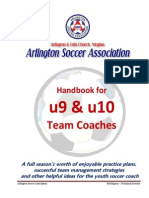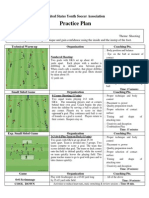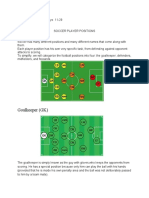0 ratings0% found this document useful (0 votes)
180 viewsKNVB Coaching Corner - No. 11
KNVB Coaching Corner - No. 11
Uploaded by
Amalia CrockerThe past World Cup was a great opportunity to see some great examples of these variations. A coach wants to make players aware of the opportunities and threats that can occur. The main aim in playing defense is to disrupt the build-up and to prevent goals.
Copyright:
© All Rights Reserved
Available Formats
Download as PDF, TXT or read online from Scribd
KNVB Coaching Corner - No. 11
KNVB Coaching Corner - No. 11
Uploaded by
Amalia Crocker0 ratings0% found this document useful (0 votes)
180 views2 pagesThe past World Cup was a great opportunity to see some great examples of these variations. A coach wants to make players aware of the opportunities and threats that can occur. The main aim in playing defense is to disrupt the build-up and to prevent goals.
Copyright
© © All Rights Reserved
Available Formats
PDF, TXT or read online from Scribd
Share this document
Did you find this document useful?
Is this content inappropriate?
The past World Cup was a great opportunity to see some great examples of these variations. A coach wants to make players aware of the opportunities and threats that can occur. The main aim in playing defense is to disrupt the build-up and to prevent goals.
Copyright:
© All Rights Reserved
Available Formats
Download as PDF, TXT or read online from Scribd
Download as pdf or txt
0 ratings0% found this document useful (0 votes)
180 views2 pagesKNVB Coaching Corner - No. 11
KNVB Coaching Corner - No. 11
Uploaded by
Amalia CrockerThe past World Cup was a great opportunity to see some great examples of these variations. A coach wants to make players aware of the opportunities and threats that can occur. The main aim in playing defense is to disrupt the build-up and to prevent goals.
Copyright:
© All Rights Reserved
Available Formats
Download as PDF, TXT or read online from Scribd
Download as pdf or txt
You are on page 1of 2
KNVB Academy // 2008 Translation: Paul Driesen
As a follow-up to one of the previous
articles we will look at what a coach can
do if his own team plays in a 1:4:3:3
formation and the opposing team switches
from a 1:4:3:3 formation during the game
to a 1:3:4:3. In the previous article we took
a closer look at the offense, this time we
will look at the defense.
When talking about the various team
formations/organizations, the past World
Cup was a great opportunity to see some
great examples of these variations. France
vs. Switzerland is one example, in which
France only played with one forward
(Henry). What to do as the opposing
team? How many defenders will you use
and how do you take on the attacking
midfielders of the French? Or take for
example The Netherlands vs. Serbia &
Montenegro at the same WC. Serbia
played with two forwards and the
Netherlands played 1v1 in the back. That
meant that three Dutch midfielders had to
play against two Serbian midfielders. You
can look at this from both sides. How does
Serbia deal with this possible threat and
how does the Netherlands take advantage
of these opportunities? Team
organizations/formations opposite of each
other can lead to opportunities and
threats. As the coach you want to deal
with those circumstances as well as
possible; take advantage of the
opportunities and neutralize all possible
threats.
IMPROVE THE DEFENSIVE PLAY
The main aim in playing defense is to
disrupt the build-up and to prevent goals.
A coach wants to make players aware of
the opportunities and the threats that can
occur. A threat could be that three of your
midfielders are facing four of the opposing
midfielders. A possible solution would be
that one of the defenders moves forward.
But that would mean that the three
remaining defenders would have to play
1v1. It also offers the opposing team a
better chance to disrupt your own build-up,
since you are playing three defenders
against three forwards. This offers the
other team the opportunity to immediately
put pressure on our defenders, after which
our team has to play the long ball. The
opponent then cant take advantage of the
extra man situation in midfield anymore. If
the team has defenders that are strong in
the air then this surely is an option. This
example shows you that a certain choice
of playing style goes hand in hand with the
quality of your players.
WORKING TOGETHER
The coach organizes the practice in such
a way that the players are confronted with
the above mentioned threats and
opportunities. They experience what it is
like to play against a 1:3:4:3 formation and
they can practice possible solutions. As an
example we will offer a practice exercise
that is focused on improving the co-
operation between the defenders and
midfielders after a long pass from the
goalkeeper of the opposing team (see
drawing). In this exercise the coach
focuses on:
KNVB Academy // 2008 Translation: Paul Driesen
The forward. This player is responsible
that the defender of the opposing team
cant receive the ball. Or he offers so
much pressure on the defender that this
player is forced to play the long ball. If the
defender still decides to pass the ball to a
midfielder then the pressure, applied by
the attacker, guarantees an inaccurate
pass.
The free player. The moment the long
pass is given, this player shall give support
behind his defenders. If one of the
midfielders of the other team gets the ball
then this one defender must restore the
balance. He must move forward to the
midfield or one of his defenders moves up
to midfield, after which the free man
takes over the coverage of the one
opponent whose direct opponent moved to
the midfield.
The midfielder. If the outside midfielders
squeeze well towards the side where the
ball is then there is very little or no space
for the central midfielders of the opposing
team. This means that the free man
doesnt have to cover any midfielder and
can assist his teammates where
necessary.
The opponent. The goalkeeper or a
defender plays the long ball to one of the
forwards. If the pressure applied by one of
the forwards is insufficient then one can try
to pass the ball to one of the midfielders.
METHODICAL STEPS
The coach can improve the difficulty by
coaching the opposition to outplay the 2v1
situation in the back: goalkeeper and
defender of the opposition against one
forward. The coach can also indicate that
a high ball-circulation (including the switch
pass from one wing to the other wing)
complicates the marking and support for
the other team. Of course a coach can
come up with other solutions to take
advantage of opportunities or to neutralize
certain threats. You will have to trust that
your creativity and expertise as a coach
will help you come up with some ideas to
solve these issues.
You might also like
- Chelsea FC Development Centre Training ManualDocument21 pagesChelsea FC Development Centre Training ManualSoccerCTC88% (8)
- 5 Phases of PlayDocument5 pages5 Phases of Playalimalan.aik59No ratings yet
- FCBEscola Coaches Seminar - Day 2Document11 pagesFCBEscola Coaches Seminar - Day 2cbales9967% (3)
- How To Improve Your Soccer Team Players - Elite Book For Elite PlayerFrom EverandHow To Improve Your Soccer Team Players - Elite Book For Elite PlayerNo ratings yet
- Prisoner of 2nd Ave Robbed CutDocument5 pagesPrisoner of 2nd Ave Robbed CutAmalia Crocker0% (1)
- FCB Escola Coaches Seminar-Day 1Document10 pagesFCB Escola Coaches Seminar-Day 1cbales9988% (8)
- Activity 4 - Training SessionDocument5 pagesActivity 4 - Training SessionDavid100% (1)
- 3 Week Pre-Season Training PlanDocument45 pages3 Week Pre-Season Training Planapi-237441903100% (3)
- Coaching Logbook Soccer - pdf.1Document18 pagesCoaching Logbook Soccer - pdf.1Bikash PradhanNo ratings yet
- Attacking Team PlayDocument10 pagesAttacking Team PlayFako NamoNo ratings yet
- Soccer Skills Training For Young Players | The Key To Win: More Than 80 DrillsFrom EverandSoccer Skills Training For Young Players | The Key To Win: More Than 80 DrillsNo ratings yet
- Concept Soccer : A Step by Step Method to Score Goals and Develop PlayersFrom EverandConcept Soccer : A Step by Step Method to Score Goals and Develop PlayersNo ratings yet
- KNVB Coaching Corner - No. 5Document2 pagesKNVB Coaching Corner - No. 5Amalia CrockerNo ratings yet
- BuildUp From OpenPlayDocument17 pagesBuildUp From OpenPlayAstrid LagaisseNo ratings yet
- Lwysa Book 10Document54 pagesLwysa Book 10Andohar PurbaNo ratings yet
- Zonal 1v1 2v2 Small Sided GameDocument2 pagesZonal 1v1 2v2 Small Sided GameLeonardo SenatoreNo ratings yet
- U10 Training SessionsDocument12 pagesU10 Training SessionsEldin PuskaNo ratings yet
- Dribbling Competition and 1v1Document3 pagesDribbling Competition and 1v1eretriaNo ratings yet
- Nscaa Coaching Formula - Stage 1 (3-5 Year Old Players)Document1 pageNscaa Coaching Formula - Stage 1 (3-5 Year Old Players)Ricardo LuizNo ratings yet
- Wayne Harrison On Intelligent Youth Player Development and Creating Soccer AwarenessDocument7 pagesWayne Harrison On Intelligent Youth Player Development and Creating Soccer AwarenessRenato Pirša100% (1)
- NEC Nijmegen 3v3 AttackingDocument2 pagesNEC Nijmegen 3v3 AttackingLeonardo SenatoreNo ratings yet
- Broture U8U9 Training Guide Final 1Document25 pagesBroture U8U9 Training Guide Final 1jun chenNo ratings yet
- Academy Session 1Document1 pageAcademy Session 1ddsayangNo ratings yet
- Expansive Football - The Second PhaseDocument3 pagesExpansive Football - The Second PhaseAlexis DavidNo ratings yet
- 72.positional Training FCB LFCDocument6 pages72.positional Training FCB LFCJudicael NoahNo ratings yet
- Dribble Training Number 3Document3 pagesDribble Training Number 3Fazlurohman azinarNo ratings yet
- 2UUFaXQAzy PES09 E 073 0926 UBDocument1 page2UUFaXQAzy PES09 E 073 0926 UBHenry ChanNo ratings yet
- FINAL-RONDOS-2022Document37 pagesFINAL-RONDOS-2022Pavel BartolottiNo ratings yet
- U9 U10 CurriculumDocument26 pagesU9 U10 CurriculumSam GillNo ratings yet
- 11&12 Coaching BookletDocument35 pages11&12 Coaching Bookletصلاح الدينNo ratings yet
- Parents Coaches SessionDocument34 pagesParents Coaches SessionSMS_SkillsNo ratings yet
- 15 Exercicios - SUB9 - SUB10 Coaching BookletDocument37 pages15 Exercicios - SUB9 - SUB10 Coaching Bookletpffpinto80No ratings yet
- Kaya FC Academy Behavioral FrameworkDocument14 pagesKaya FC Academy Behavioral Frameworkjun chenNo ratings yet
- Coaches Handbook U9 U10Document40 pagesCoaches Handbook U9 U10Franklin Justniano VacaNo ratings yet
- FFA SoccerDocument9 pagesFFA SoccerBosko0% (1)
- U10 - Receiving The Ball in The Air IIDocument1 pageU10 - Receiving The Ball in The Air IIluyouthsoccerNo ratings yet
- Goalkeeper Practice Plans1Document78 pagesGoalkeeper Practice Plans1kuntulbesarNo ratings yet
- U10 12 Curriculum 2nd EditionDocument43 pagesU10 12 Curriculum 2nd Editionjun chenNo ratings yet
- Modern Defensive ShemesDocument3 pagesModern Defensive ShemesSead BalihodzicNo ratings yet
- Attack From The FlanksDocument7 pagesAttack From The FlanksNAYIM OZNAIM100% (1)
- U10 - Passing & Receiving IIDocument1 pageU10 - Passing & Receiving IIluyouthsoccerNo ratings yet
- B Licence GK ModuleDocument47 pagesB Licence GK Modulekarlhansharbers85100% (2)
- 4 3 3formationv2Document6 pages4 3 3formationv2Jerson Daniel Alcaraz Uliambre100% (1)
- Practice Plan: United States Youth Soccer AssociationDocument1 pagePractice Plan: United States Youth Soccer AssociationluyouthsoccerNo ratings yet
- 3 5 2Document67 pages3 5 2Cheri WilsonNo ratings yet
- 2013 Parent Handbook 2013 05Document15 pages2013 Parent Handbook 2013 05FontapinhasNo ratings yet
- The Philosophy of The Philosophy of Youth Development Youth Development at The Belgian Fa at The Belgian FaDocument38 pagesThe Philosophy of The Philosophy of Youth Development Youth Development at The Belgian Fa at The Belgian Famatjaz_krajnikNo ratings yet
- U10 PPT Andover U10Document15 pagesU10 PPT Andover U10jun chen100% (1)
- Horst Wein 3 On 3 Samples PDFDocument30 pagesHorst Wein 3 On 3 Samples PDFrtieffenbergNo ratings yet
- U14 2019春季课程计划Document24 pagesU14 2019春季课程计划jun chenNo ratings yet
- Tims Group - SportsDocument9 pagesTims Group - Sportsapi-312593742No ratings yet
- Chris Wilder's Attacking Centre Backs - in The Example of Sheffield United's 1-3-5-2 - Alex Trukan 2020Document59 pagesChris Wilder's Attacking Centre Backs - in The Example of Sheffield United's 1-3-5-2 - Alex Trukan 2020CyberPlay Cybercenters0% (1)
- Soccer Fitness Tests PDFDocument2 pagesSoccer Fitness Tests PDFAndi GunawanNo ratings yet
- 1v1 Shooting PDFDocument1 page1v1 Shooting PDFDragan MiskovicNo ratings yet
- Defending in Own Half PhaseDocument2 pagesDefending in Own Half PhaseBogdan TudorNo ratings yet
- Def 1 V 1Document13 pagesDef 1 V 1jun chenNo ratings yet
- Beginning 11v11Document4 pagesBeginning 11v11maradonagol100% (3)
- 2 Ball Aerobic PossesionDocument2 pages2 Ball Aerobic PossesionLucian NicolauNo ratings yet
- Finishing 1v1 With The GoalkeeperDocument1 pageFinishing 1v1 With The GoalkeeperGiovanni AlemaoNo ratings yet
- Five Favourite Practices To Create and Exploit WidthDocument3 pagesFive Favourite Practices To Create and Exploit Widthapi-140363601No ratings yet
- Transitioning BpoDocument4 pagesTransitioning BpoFazlurohman azinarNo ratings yet
- U10 10weeks 4Document10 pagesU10 10weeks 4jun chenNo ratings yet
- Dribbling and Running With The Ball 3Document1 pageDribbling and Running With The Ball 3Giovanni AlemaoNo ratings yet
- العاب ترفيهية بكرة القدمDocument23 pagesالعاب ترفيهية بكرة القدمjaimito jmgmmm2726yahoo.comNo ratings yet
- The Second CircleDocument282 pagesThe Second CircleAmalia CrockerNo ratings yet
- Italians Erie A Academy TrainingDocument78 pagesItalians Erie A Academy TrainingAmalia CrockerNo ratings yet
- KNVB Coaching Corner - No. 5Document2 pagesKNVB Coaching Corner - No. 5Amalia CrockerNo ratings yet
- KNVB Coaching Corner - No. 4Document2 pagesKNVB Coaching Corner - No. 4Amalia CrockerNo ratings yet
- KNVB Coaching Corner #13Document2 pagesKNVB Coaching Corner #13Amalia CrockerNo ratings yet
- KNVB Coaching Corner 8Document2 pagesKNVB Coaching Corner 8Nikos NikidisNo ratings yet
- KNVB Coaching Corner 1pdfDocument2 pagesKNVB Coaching Corner 1pdfNikos NikidisNo ratings yet
- WS5 Hans WesterhofDocument69 pagesWS5 Hans WesterhofAmalia Crocker100% (2)
- U17 Building Up From The Back in A 4-3-3Document8 pagesU17 Building Up From The Back in A 4-3-3Χριστοφυλλάκης Λογιστικές Υπηρεσίες100% (1)
- Schalke BayernDocument4 pagesSchalke Bayernapi-83605395No ratings yet
- MSC 30 Pressing Exercises EbookDocument33 pagesMSC 30 Pressing Exercises EbookadamabuNo ratings yet
- 29 World Class Coaching Training SessionsDocument104 pages29 World Class Coaching Training SessionsRicardo Luiz100% (2)
- US Youth Soccer Player Development ModelDocument117 pagesUS Youth Soccer Player Development ModelAngeline Jolie AbdullahNo ratings yet
- 5 3防守分配Document7 pages5 3防守分配afodfcaviyfqrd100% (1)
- A Level Pe Coursework ExemplarDocument6 pagesA Level Pe Coursework Exemplarafazakemb100% (2)
- Attacking After Gaining Possession in The Middle Third Counter AttackDocument9 pagesAttacking After Gaining Possession in The Middle Third Counter Attackapi-246218373No ratings yet
- Football Manager Player Role Combinations and Duty Pairs - Passion For Football ManagerDocument29 pagesFootball Manager Player Role Combinations and Duty Pairs - Passion For Football ManagerAbdan Shidqi100% (1)
- Principels of PlayDocument58 pagesPrincipels of PlayKhusnul YaqienNo ratings yet
- Elite Soccer 13Document18 pagesElite Soccer 13Chris Holt100% (2)
- Tactical Report - Seattle SoundersDocument15 pagesTactical Report - Seattle SoundersJuan Manuel Navarrete100% (2)
- Wonderkid 15Document18 pagesWonderkid 15Farid Ahmad ShalahuddinNo ratings yet
- Build-Up Into Strikers: Rene MeulensteenDocument1 pageBuild-Up Into Strikers: Rene MeulensteenILO 007No ratings yet
- Bai Tap Correct The MistakesDocument6 pagesBai Tap Correct The MistakesnguyenngocquynhchiNo ratings yet
- Defensive & Offensive PrinciplesDocument11 pagesDefensive & Offensive PrinciplesSam Gill100% (1)
- ITK 2013 Rangnick - De.en PDFDocument8 pagesITK 2013 Rangnick - De.en PDFadu rawdiNo ratings yet
- Defending From The Front 4 3 3Document4 pagesDefending From The Front 4 3 3cuacose100% (2)
- Soccer DrillsDocument176 pagesSoccer Drillsbutaru100% (1)
- Barcelona Tiki Taka Tactics - Football Manager 2015 Possession Tactic - Passion For Football ManagerDocument44 pagesBarcelona Tiki Taka Tactics - Football Manager 2015 Possession Tactic - Passion For Football ManagerIrham Sevenfoldism100% (3)
- Goalkeeper (GK)Document7 pagesGoalkeeper (GK)E.J. PelayoNo ratings yet
- Full Switching Play SessionDocument6 pagesFull Switching Play SessionLucian Nicolau80% (5)
- Barcelona's Defensive WoesDocument5 pagesBarcelona's Defensive WoesSachin Prabhu RamNo ratings yet
- Best FM 2016 TacticsDocument28 pagesBest FM 2016 TacticsMuhammad Mubashir HassanNo ratings yet
- Chris Wilder's Attacking Centre Backs - in The Example of Sheffield United's 1-3-5-2 - Alex Trukan 2020Document59 pagesChris Wilder's Attacking Centre Backs - in The Example of Sheffield United's 1-3-5-2 - Alex Trukan 2020CyberPlay Cybercenters0% (1)
- FIFA ManualDocument257 pagesFIFA ManualMounir FellahiNo ratings yet


































































































